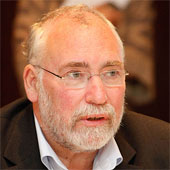Sicily: The Good, the Bad and the Ugly
How is Sicily's ancient culture coping with globalization?
December 28, 2002
Few places on earth have been so central to globalization in the past as Sicily. This island off the toe of the boot of Italy — with a population today of five million people — has been a crossroads of world civilizations for almost 3,000 years.
It started in classical times. Syracuse was one of the most thriving and influential centres of Greek civilization. The Greeks, the Romans, the Saracens, the Normans, the Catalans, the French, the Austrians — and, of course, successive Italian regimes — have all passed through the area and left their mark on it.
The magnificent architecture of the palaces and churches of its towns and cities (such as Palermo, Cefalu, Taormina, Messina, Erice, and Enna) covers the Romanesque, the Norman, the Gothic, the Renaissance and the Baroque eras.
Sicily's intellectual contribution to Italy and the world spans across the centuries — from Marcus Tullius Cicero (106-43 B.C.), who began his writing career while residing in Enna, to modern authors such as Luigi Pirandello (1867-1936), who was the winner of the 1934 Nobel Prize for Literature.
Sicily is also a major center for Italian folksong and folk art. It is especially renowned for its puppetry — and cuisine. The successive invasions of diverse cultures and ethnic groups are reflected in the make-up and diversity of the population.
The stereotyped very dark-haired and especially dark-eyed Sicilian certainly exists, but so do people with fairer complexion. Heterogeneity is a characteristic and an important part of the island's attraction.
The island's topography is magnificent. With the Etna currently in eruption, "breath-taking" is only one of the milder words that convey the feeling of awe in admiring Sicily's natural wealth.
One is also struck by the extreme gentility of the Sicilian people, their warmth and kindness. There are obviously exceptions — and we will come to those!
There is also a feel of a strong sense of community. For example, a local marching band in Syracuse on a Friday evening had everybody coming out of offices and shops to wave and urge them on. That was impressive evidence of the island's sense of community.
Though Sicily may have been the center of civilizations in the past, today it is rather on the periphery of globalization. There are no significant foreign investments in Sicily and, with the important exception of STMicroelectronics in Catania under the leadership of the Sicilian entrepreneur Pasquale Pistorio, no high-tech companies.
Exports are primarily in primary and agricultural products, along with some light manufacturing, such as textiles. Sicily's magnificent topography does not include big sandy beaches. Hence, the tourism industry here is pretty much limited to archaeological tours and members of the huge Sicilian "diaspora" looking for roots.
That is not entirely bad. Just consider how much physical and spiritual damage tourism has done to many parts of the Mediterranean.
But, in truth, Sicily is poor. Palermo, the island's capital, is geographically, but also in other respects — like garbage collection — closer to Tunis than to Milan.
It is true that there are virtually no beggars And there is no sense of insecurity in walking through the towns — even at night. However, although one encounters very little misery, there is an overall aura of poverty.
In the early 21st century, with all the wealth Europe has accumulated, people should not have to live in such squalor as they do in Sicily.
And it is clear that the poverty and neglect are hurting the beautiful urban landscapes. In Sicily, though the ancient monuments (such as Segesta, Solinunte, Agricento and Syracuse) are all well preserved, most of the cities are disintegrating.
Buildings that have been preserved for centuries seem destined to disappear very quickly in this one. Walking around parts of Palermo and seeing so many totally dilapidated buildings reminded me of Sarajevo. But in Sarajevo, the decay was due to a very recent war.
In Palermo it is general neglect, both locally and by Rome, including the neglect of rebuilding after the damage inflicted by battles during World War II … 60 years ago! But grinding poverty leaves little resources — and perhaps even less reason — to maintain these ancient urban areas.
Worse, the really ugly in Sicily is the existence and power of rapacious, mafia-connected real estate developers and construction companies. They have no hesitation in destroying ancient landmarks to put architectural atrocities in their place.
Of course, the architectural atrocities committed by the mafia pale into insignificance when compared to the human atrocities.
A sad fact: The international airport at Palermo is named after Giovanni Falcone, the courageous prosecutor who had pursued the mafia with great zeal and growing effect.
In May 1992, his motorcade was hit by 300 kilograms of explosives — killing him, his wife, Francesca and three of his bodyguards.
That is how even tourists get a stark reminder of what is wrong with Sicily. Essentially, the Italian government has not yet really established the proper rule of law there. No doubt that is another reason for the island's poverty.
It is surely a tragedy that a place that was once one of the centers of civilization has been reduced to a backwater known more for violent crime than for its illustrious history.
Finally, a visit to Sicily brings up another question. Should not all of us around the world who care about the past — and the future — of humankind consider carefully our own responsibilities towards ensuring that Sicily — and other places like it — do not simply descend into barbarity?
Sicily, a cradle of many ancient civilizations, must not be a coffin of 21st century globalization.
Read previous
A Religious World War in the Making?
December 27, 2002
